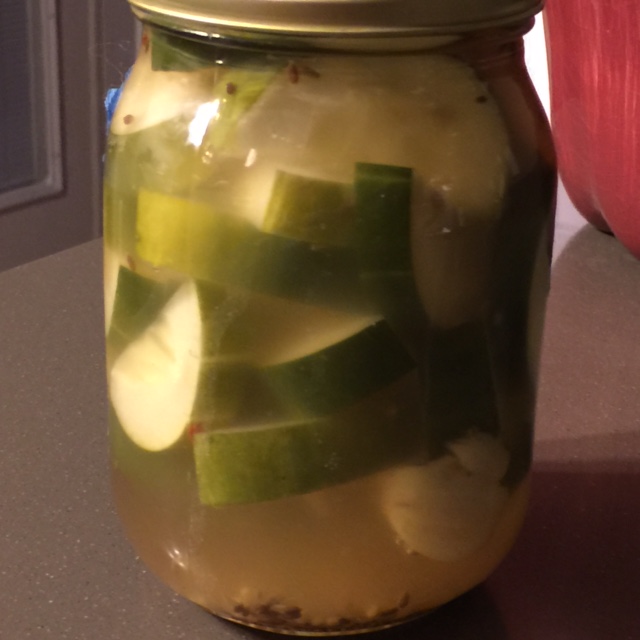So I decided it was time to make some more pickles. Went to whole foods to grab some fresh dill and garlic, so I could use up the cucumbers I got a couple of days ago.
Here's my process and recipe. (Winged the recipe, since I forgot to write it down last time I made them.)
What you'll need:
- 1 gallon glass container or pickle crock
- 1 gallon ziplock bag or crock weights
- 1 gallon distilled water.
- Diamond kosher salt (6 Tbsp)
- 9 to 12 large pickling cucumbers, or enough to fill your jar so the cucumbers can't float up.
- Fresh dill (2-4 sprigs)
- Fresh garlic (2-4 cloves)
- Whole black peppercorns (1 tsp)
- Mustard seeds (1 tsp)
- Dill seeds (1 tsp)
- Whole coriander (1/2 tsp)
- Ancho chilies (2-6 peppers)
- All-Spice berries (2-4 whole berries)
- Bay leaves (1-3 leaves)
View attachment ImageUploadedByHome Brew1444516645.217562.jpg
I like to start off by mixing my brine. I use (3) quart size mason jars, and fill them each with 3 cups of distilled water, and 2 Tbsp of diamond kosher salt. Put a lid on them and shake to dissolve the salt.
Next you want to wash and scrub any dirt off of your cucumbers with a bristle brush.
** This should be a scrubbing brush that is only used on vegetables **
View attachment ImageUploadedByHome Brew1444516671.928679.jpg
Next remove the last 1/8" or so, from both ends of the cucumbers.
View attachment ImageUploadedByHome Brew1444516692.791294.jpg
After the ends are removed I add the spices to the jar. For the garlic I cut off the dark ends, and then flatten them under a chef knife.
View attachment ImageUploadedByHome Brew1444516742.595955.jpg
What I added to the jar:
1/2 tsp coriander
1 tsp Whole black peppercorns
1 tsp Mustard seeds
1 tsp Dill seeds
2 Bay leaves (crushed)
3 Dill sprigs
3 All-spice berries
4 Cloves of crushed garlic
4 Ancho chiles (3 w/ seeds, 1 w/o seeds)
View attachment ImageUploadedByHome Brew1444516783.466501.jpg
Side note: If you're going to use ancho chilies with seeds, try to use unbroken peppers and twist the stem off at the very top. I found that this helps to prevent hot spots on parts of pickles where they were on the seeds, and it gives a more even spiciness to the pickles.
Put the jar on its side and start stacking your pickles into the jar.
View attachment ImageUploadedByHome Brew1444516837.560462.jpg
Once it's full, -- but not completely packed -- add about a cup or so of brine. Twist the jar back and forth in your hands fast enough, so that the spices get mixed up and don't all end up under the ends of the pickles. ( I usually do this again after they've been sitting for a few days and have shrunken.)
View attachment ImageUploadedByHome Brew1444516879.898662.jpg
Fill the jar with the last one or two cucumbers, so they are snug against one another and don't move. This may take some rearranging, or possibly cutting of a cucumber.
View attachment ImageUploadedByHome Brew1444516903.275814.jpg
Add more brine until it covers the tops of the cucumbers. Then place your ziplock bag in the jar on top of the brine. Fill the ziplock bag with the remaining brine to weigh down the cucumbers, and to make sure if the bag leaks it won't water down the brine.
** If you have brine left over, save it for when you want to move them in the fridge. I usually take the bag out and throw it away, along with the brine inside. Then use the left over brine in the jars or make more. I feel like sometimes the bag can add a plastic flavor to the brine inside, so I'd rather just make fresh brine than impart any off flavors. **
View attachment ImageUploadedByHome Brew1444516984.635793.jpg
Place in a cool dark place. I usually use a styrofoam cooler. It keeps temps pretty constant, and shields it from light or bugs.
View attachment ImageUploadedByHome Brew1444517000.924830.jpg
Then just let it sit and do its thing. Wild lactobacillus in the environment should take hold in the brine after a couple of days. As long as the cucumbers are under the brine, and your salt levels are high enough -- you should have no problems.
After about a week or so, the brine should have turned cloudy and the cucumber's skin should have changed colors from a saturated green, to a more muted pickle green.
How sour your pickles are, will determine on how long you let them sit on the counter before moving them into the fridge.
I'll post back in a week or so with the results.




